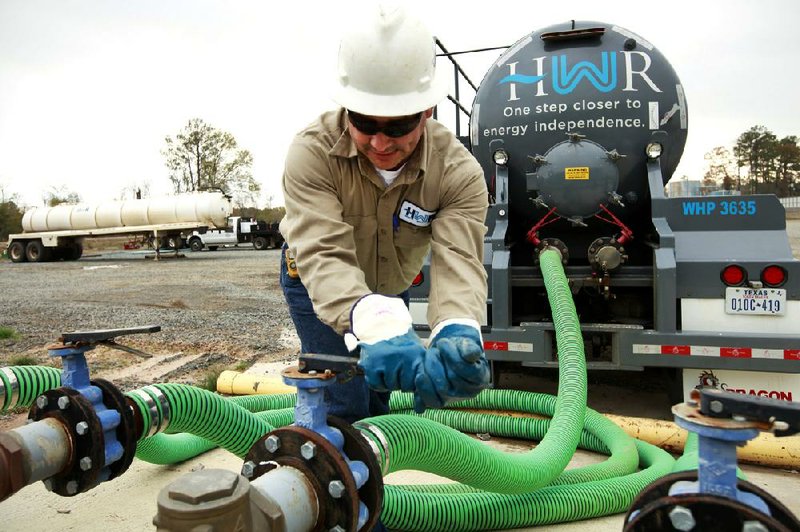LITTLE ROCK — The U.S. Environmental Protection Agency issued the first rules to combat air pollution from natural-gas drilling Wednesday, while giving companies until 2015 to meet the most stringent requirements, which are opposed by the energy industry.
The regulations will primarily affect wells drilled using hydraulic fracturing, or fracking, to free underground gas in shale formations including the Fayetteville Shale formation in north-central Arkansas. The EPA rejected a bid by the American Petroleum Institute to exempt a number of wells from the requirements.
“The president has been clear that he wants to continue to expand production of important domestic resources like natural gas, and today’s standard supports that goal while making sure these fuels are produced without threatening the health of the American people,” EPA Administrator Lisa Jackson said Wednesday in a statement.
“By ensuring the capture of gases that were previously released to pollute our air and threaten our climate, these updated standards will protect our health, but also lead to more product for fuel suppliers to bring to market,” the statement said.
An EPA draft of the rule would have put the requirements into effect in about 60 days, but the final rule delays until Jan. 1, 2015, a requirement that drillers capture gases when first tapping a well. Instead, operators must burn off that gas during the phasein period, the EPA said.
The EPA proposed the rule last year to focus on fracking, in which chemically treated water is forced underground to break up rock and free natural gas. The method has opened vast new shale-gas deposits and helped push natural-gas prices to the lowest level in a decade. Gas for May delivery fell Wednesday to $1.94 per 1 million British thermal units, the lowest intraday price since January 2002 before settling at $1.95.
The new rules will force drillers of new wells to capture components of smog and other substances that are now often released into the air or flared off when a well is first tapped.
In March 2011, pollution from natural-gas drilling in the Upper Green River Basin in western Wyoming triggered levels of ground-level ozone, the main ingredient in smog, worse than those recorded in Los Angeles, one of the smoggiest cities in the U.S.
Devon Energy Corp. has said 90 percent of its wells already capture the gas, and Southwestern Energy Co. said almost all of its wells in the Marcellus and Fayetteville shale formations collect the gas.
“Every molecule of gas you let escape out into the air is a molecule of gas you can’t sell,” Tim Hartley, a spokesman for Oklahoma City-based Devon, said in an interview.
The EPA analysis said drillers may make as much as $11 million a year after paying for the equipment to comply with the rule, because they can sell the gas that would otherwise escape into the air.
Lobbyists for companies including Devon Energy and Chesapeake Energy Corp. sought to delay and scale back the rule while rebutting environmentalists’ claims that fracking causes air pollution.
“Overall, EPA has made some important adjustments in the rules that allow” the industry to comply with the requirements, said Howard Feldman, research director for the American Petroleum Institute in Washington. “Most of the changes were constructive.”
But Feldman said most of the industry is already capturing the initial gas release.
“We don’t need [the EPA] to come and tell our members we will save you money,” Feldman said.
“Their business is natural gas. They get it that they are trying to capture as much gas as they can.”
The rules include incentives to prod drillers to use the technology called green completions, in which gas is collected right after a well is tapped, according to David Doniger, policy director for the climate and clean-air program at the Natural Resources Defense Council in Washington.
“I wish there was no phasein period,” Doniger said in an interview. “But the standards contain incentives for companies to do the right thing before the 2015 deadline.”
At the smokestack, power generated from natural-gas emits about half the carbon dioxide as coal, earning it favor with some environmental groups worried about climate change. Research on emissions from fracking itself has prompted questions about whether natural gas is friendlier to the climate because of methane releases at the well.
Stray emissions from the drilling process can change the calculation that natural gas is cleaner. Some of the largest air emissions occur during the initial three- to 10-day period called “flow back,” when fracturing fluids, water and reservoir gas rise to the surface at a high velocity and volume, according to the EPA. Systems required by the EPA rule would separate water from the gas and feed it into a pipeline.
Besides the new standards for oil and gas wells, the EPA also on Wednesday updated existing rules for natural-gas processing plants, storage tanks and transmission lines that will reduce amounts of cancer-causing air pollution, such as benzene, and reduce methane — the main ingredient in natural gas, but also one of the most potent globalwarming gases.
Information for this article was contributed by Mark Drajem and Jim Efstathiou Jr. of Bloomberg News; and by Dina Cappiello of The Associated Press.
Front Section, Pages 1 on 04/19/2012
